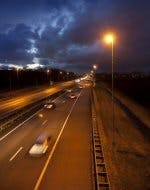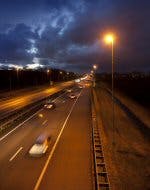Philips – in collaboration with the Rijkswaterstaat (RWS, the Dutch highway authority), contractors Gebroeders Van der Lee and consultants Spectrum – has installed LED lighting along a 7km-length of the A44, one of the busy highways feeding commuters into and out of Amsterdam.
Around 60% of the energy consumed by the Netherlands’ motorways and waterways is used for lighting. Philips says that public authorities like the RWS are increasingly seeking lighting solutions that meet targets for reducing energy consumption, and at the same time comply with norms and standards that ensure safety for motorists.
The A44 project uses Philips’ SpeedStar LED luminaires, which combine bright, white LED light with a dimming capability that reduces the light output and consequently the energy consumption. The Philips spokesperson said that the dimming system raises and lowers the light output automatically according to the time of day, and also in case of emergencies or rainfall.
The dimmable LED lighting installation on the A44 will save up to 40% of the energy consumed by the previous lighting on the highway, with a similar reduction in CO2 emissions. The total energy saving is expected to be around 180,000 kWh per year –equivalent to the energy consumption of 50 households.
The RWS also aims to use the A44 installation to learn more about the use of innovative LED-based lighting solutions on Dutch highways.
Philips says that the Speedstar LED luminaires are designed to ensure that all the emitted light is focused on the highway, significantly minimizing light pollution that can otherwise be distracting for local residents as well as animals.
A further benefit is that the longer lifetime of LED lighting, coupled with the ability to remotely monitor the installation via a central control, will help minimize maintenance needs. This will both reduce operational costs and improve traffic planning, to reduce disruption to road users.
Switching off is a false economy
In related news, Philips Lighting UK says that adopting modern street-lighting technologies such as LEDs and control systems offer potentially greater savings than simply turning the lighting off.
Reductions in street lighting are seen by a majority of councils in the UK as an easy option to cut costs in response to local-authority budget cuts imposed by central government. Philips Lighting believes that this is a false economy, and likely to end up costing more than it saves.
“Three-quarters of councils are said to be prioritizing cuts in street lighting,” says Andy Gowen, Director of Philips Outdoor Lighting Solutions. “The UK has an estimated 6.9 million lights around the country, costing some £30 each to power, or £207 million in total. On the face of it the simple calculation is, turn them off for 10 per cent of the time and save £20 million.”
However, says Gowen, the reality is that adapting the day/night sensor on each street lamp will cost an average £21 per unit [according to the Institute of Lighting Professionals], on top of which the running costs still have to paid. “Achieving savings is not as straight forward and certainly not as high as we are led to believe,” he says.
Gowen also argues that shaving an hour or two of street lighting at the start and end of the day is likely to have undesirable impacts on transport, personal security and safety. For example, data shows that good street lighting cuts the number and severity of night-time road accidents by up to 30 per cent.
Surprisingly, councils in the UK have no statutory obligation to light the streets. However, asserts Gowen, “for the overall public benefit, local authorities would be advised to abandon any thoughts that street lighting is an appropriate place to look for savings: it isn’t.”
Instead, argues Gowen, councils would do well to turn the argument on its head. “By looking for upgradeable and controllable lighting solutions that provide longer-term savings alongside superior illumination, councils are future proofing their investment to ensure that they can always maximize their savings,” he says.
“LEDs are the future. The running costs of LED street lights are 70 per cent lower than lights with conventional lamps, so that the current national spending of £207 million a year could drop to £62 million. That’s a better way to go than simply switching off the lights.”







